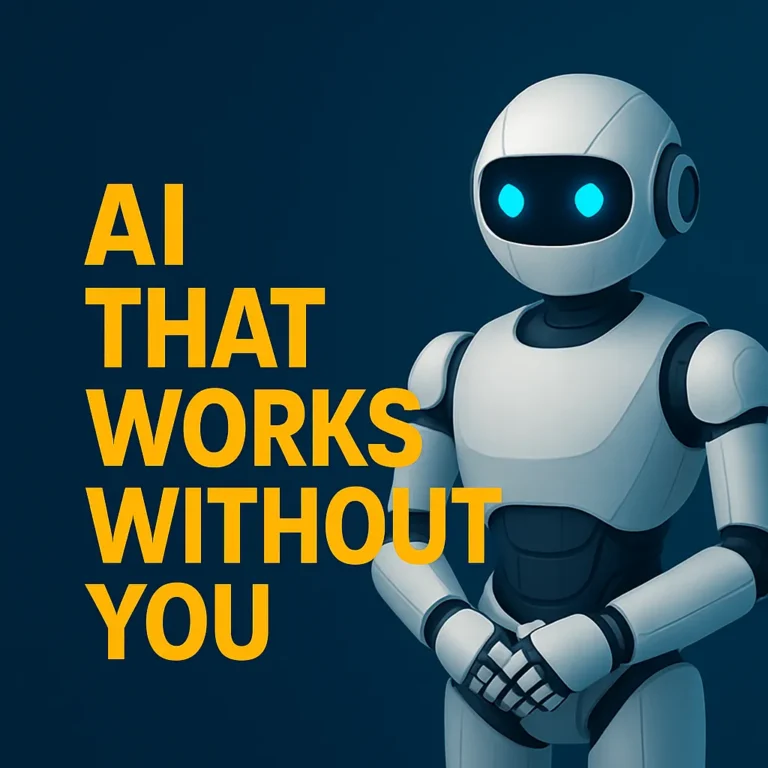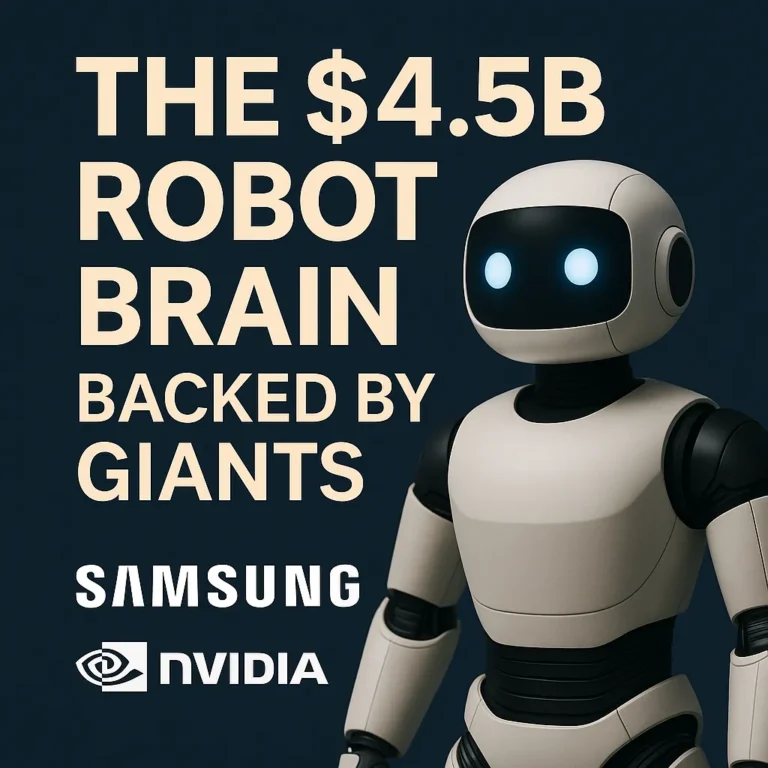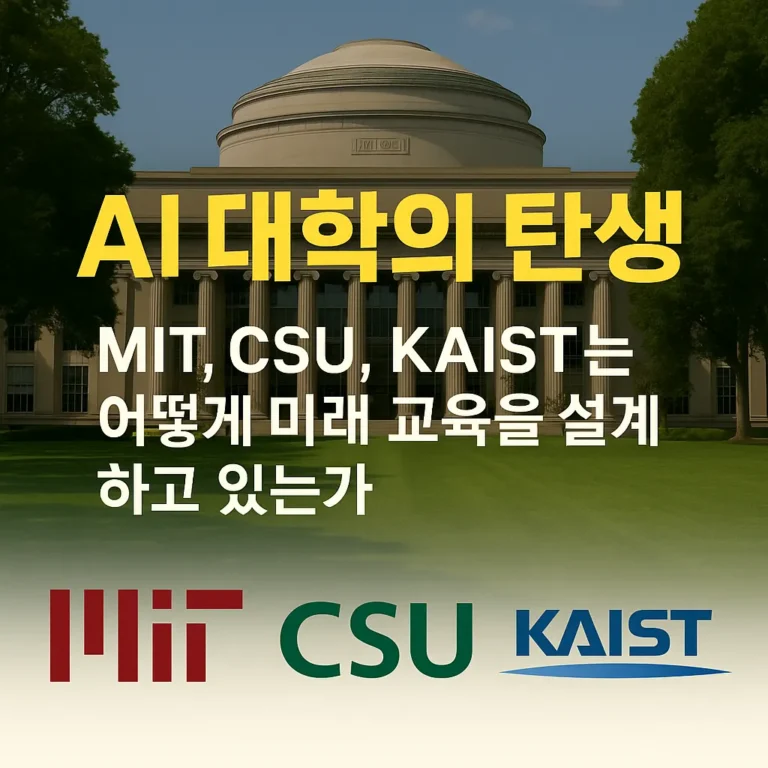Meta Scale AI Deal: The Ultimate $14.3B Bet on AGI Leadership
The Meta Scale AI deal is not just another big-tech transaction. It marks a defining moment in the race toward artificial general intelligence. With a $14.3 billion investment for a 49 percent stake in Scale AI, Meta has taken one of its boldest strategic steps since acquiring Instagram or Oculus. But this time, the prize is far greater: establishing itself as a dominant force in the next era of artificial intelligence.
Scale AI, a San Francisco-based infrastructure company, is known for providing high-quality data labeling, evaluation, and model alignment tools. It has quietly powered leading AI labs including OpenAI, Microsoft, and even the U.S. Department of Defense. With this deal, Scale becomes the technical foundation for Meta’s AGI initiative. This move signals a shift in Meta’s ambitions, expanding well beyond social platforms and ad optimization.
At the center of the deal is Alexandr Wang, the 28-year-old co-founder and CEO of Scale AI. As part of the agreement, Wang joins Meta to lead its new superintelligence division. He brings with him not only deep technical expertise but also executive leadership, a founder’s mindset, and significant policy influence across the AI ecosystem.
In this blog, we explore why the Meta Scale AI deal could reshape the competitive dynamics of AI development. We will examine what makes Scale such a valuable infrastructure partner, how this $14.3 billion investment fits into Meta’s long-term vision, and what it means for investors, technologists, and the future of intelligent systems.
What the $14.3B Meta Scale AI Deal Really Means
On the surface, the Meta Scale AI deal looks like a massive capital injection into a promising infrastructure company. But the scale and structure of the investment reveal something deeper: Meta is repositioning itself to dominate the next generation of artificial intelligence by owning the most strategic layer of the AI value chain.
Meta has invested $14.3 billion to acquire a 49 percent stake in Scale AI. This puts the startup’s total valuation at approximately $29 billion, a dramatic leap from its previous round. Importantly, Meta has not taken board control or full ownership. Instead, it has secured significant influence without triggering immediate antitrust concerns, allowing Scale to retain operational independence.
What makes this deal strategically unique is that Meta is embedding itself directly into the data infrastructure layer. This is the part of the AI stack that turns raw data into structured, validated inputs for model training and evaluation. Historically, Meta has focused heavily on model development with its LLaMA series, but it lacked end-to-end control of the data pipeline. Now, with Scale AI, it gains access to an engine that supports labeling, alignment, and safety testing.
To understand the significance of this move, it helps to compare Meta’s investment with other major AI bets made by big tech leaders in recent years. As shown in Table 1, Meta’s deal stands as the single largest strategic investment in the AI infrastructure space to date.
Table 1. Big Tech’s Largest AI Investments (2023-2025)
| Company | Strategic Move | Investment Size | Core Objective |
|---|---|---|---|
| Meta | Scale AI Stake | $14.3B | AGI infrastructure, model alignment, leadership |
| Microsoft | OpenAI Partnership | $13B+ | Access to GPT models, Azure ecosystem integration |
| Amazon | Anthropic Investment | $4B | Strengthening Bedrock and cloud dominance |
| Gemini + Anthropic Support | $3B+ | Competing with OpenAI, internal LLM acceleration | |
| xAI (Elon Musk) | Compute Scaling + Talent Grab | Undisclosed | Independent AGI development platform |
Meta’s $14.3B investment in Scale AI tops the list in terms of size and long-term strategic depth. The deal anchors Meta’s move from open-source model builder to full-stack AI infrastructure player.
Beyond the financials, Meta is also gaining talent, tools, and technical leverage. Alexandr Wang, Scale AI’s co-founder and CEO, will now lead Meta’s new superintelligence division. His dual role as a technical founder and public-facing AI policy voice adds credibility to Meta’s renewed AGI ambitions.
The Meta Scale AI deal therefore represents more than a capital deployment. It signals a deliberate shift in Meta’s role, moving from a fast follower to a full-system integrator. Meta now gains influence over every stage of the model lifecycle, including data ingestion, evaluation, alignment, and deployment. This level of vertical integration reduces its dependence on external providers and strengthens its competitive position in the rapidly evolving landscape of frontier AI.
Inside Sc3. Inside Scale AI’s Data Infrastructure
To grasp the full implications of the Meta Scale AI deal, it is important to understand the infrastructure Meta is investing in. Scale AI is not building models itself. Instead, it serves as a foundational layer that transforms raw data into structured, reliable, and deployment-ready intelligence. This behind-the-scenes role is increasingly becoming the most valuable position in the AI stack.
Scale AI operates at the intersection of machine automation and human expertise. Its platform helps leading AI companies transform massive volumes of unstructured data into clean, annotated, and aligned datasets. These datasets power applications in autonomous driving, robotics, defense systems, and, critically, large language model development.
▪ AI-Driven Labeling with Human Oversight
Scale’s core platform delivers data labeling across a wide range of formats. This includes:
- Images and videos for computer vision and robotics
- LIDAR and 3D point clouds for simulation and spatial modeling
- Natural language text for LLMs and chat agents
- Multimodal data for complex agents and decision-making models
The process combines automated pre-labeling with human verification. This hybrid system allows for faster throughput while preserving the accuracy needed for high-stakes AI use cases.
▪ SEAL: The Evaluation and Alignment Lab
Scale’s influence extends far beyond data annotation. Its SEAL (Scale Evaluation and Alignment Lab) division specializes in evaluating models for alignment, safety, and reliability. SEAL develops tools for red-teaming, prompt injection testing, and scenario-based stress evaluations.
One of SEAL’s most notable contributions is a benchmark called Humanity’s Last Exam. This benchmark simulates high-stakes real-world decision-making scenarios, pushing LLMs to reason across multiple steps, verify facts, and avoid harmful outputs. SEAL’s tools are now used by both private labs and public agencies focused on AI safety.
▪ The Infrastructure That Connects Data to Deployment
Scale has built an end-to-end data operations platform that bridges the messy world of raw input data with the structured demands of model training. The system includes dataset validation, filtering, augmentation, and formatting workflows. These workflows make it easier for organizations to train high-performance models that are not only powerful but also interpretable and safe.
With Scale now integrated into Meta’s AI ecosystem, the company gains the ability to produce cleaner training data, evaluate model behavior more effectively, and reduce the time required to take models from prototype to production.
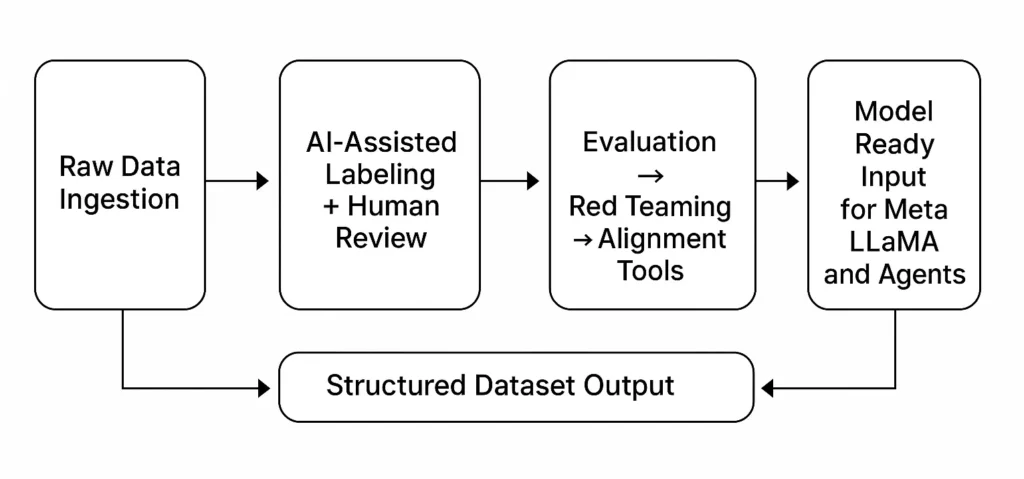
Scale AI’s infrastructure converts raw data into model-ready intelligence. The Meta Scale AI deal gives Meta a strategic advantage in owning this critical layer of the AI supply chain.
The Alexandr Wang Factor in the Meta Scale AI Deal
While the technical infrastructure behind the Meta Scale AI deal is critical, the most underestimated asset in the transaction may be Alexandr Wang himself. At just 28 years old, Wang is not only one of the youngest self-made billionaires in tech but also a strategic force shaping how artificial intelligence is developed, governed, and deployed at scale.
Wang co-founded Scale AI in 2016 after leaving MIT. Under his leadership, Scale evolved into a foundational player in the AI ecosystem. The company supplies labeled data and evaluation services to leading organizations including OpenAI, Microsoft, Toyota, and the U.S. Department of Defense. Wang’s rare combination of technical depth, startup discipline, and public policy credibility makes him one of the most influential figures in frontier AI today.
As part of the Meta Scale AI deal, Wang will now lead Meta’s newly formed superintelligence division. This role goes far beyond advisory status. He will be responsible for integrating Scale’s alignment systems and data infrastructure into Meta’s larger AI strategy. His oversight will likely touch areas such as LLaMA model development, agent-based systems, and Meta’s broader ambitions around artificial general intelligence.
This decision represents a clear organizational shift at Meta. Rather than relying solely on internal promotion or traditional research leadership, Meta has chosen to elevate a founder who understands both the business and engineering sides of AI infrastructure. Wang has already proven his ability to scale applied AI under demanding conditions. Now he is in a position to shape Meta’s long-term priorities around safety, deployment, and scalability.
His presence also strengthens Meta’s influence in global AI policy. Wang has testified before the U.S. Congress, contributed to AI safety initiatives, and co-authored letters on responsible AGI development. By bringing him into a formal leadership role, Meta gains a more credible seat at the table in regulatory and governance discussions around advanced AI.
Meta’s AI Strategy Before the Scale AI Deal
Before partnering with Scale AI, Meta’s AI strategy was built around open-source models and cutting-edge research. The company released its LLaMA (Large Language Model Meta AI) series with the goal of democratizing access to powerful models. This approach gained academic support and community adoption, but it exposed critical weaknesses in infrastructure, safety, and deployment.
Meta’s LLaMA models showed strong performance on many benchmarks. However, unlike competitors such as OpenAI and Anthropic, Meta lacked a packaged solution for enterprise users. Its models were released without commercial APIs, safety alignment tooling, or integrated deployment platforms. This created a gap between research excellence and product viability.
Another shortcoming was in model evaluation and red-teaming. While Meta provided documentation and guidelines, it did not have a robust internal system for stress testing its models. Tools for prompt injection resistance, alignment scoring, and safety auditing were limited. This made its models less attractive for use in sensitive or regulated environments.
Operationally, Meta’s AI teams were not fully integrated. Model development, compute infrastructure, and user interface design were managed by separate units. This slowed iteration and created organizational friction, especially in comparison to the tightly coordinated teams at OpenAI or Google DeepMind.
That said, Meta had strategic strengths. It possessed elite AI research talent, massive platform data, and a growing in-house hardware ecosystem. What it lacked was a unified infrastructure to transform its research into deployable, trustworthy systems. That infrastructure is exactly what Scale AI now provides.
The partnership brings in data alignment, human-in-the-loop validation, and evaluation pipelines that Meta previously did not control. It enables a full-stack approach to AI development, where every stage from data labeling to safety benchmarking is coordinated within a single ecosystem.
For a visual comparison of Meta’s position before this deal, see the attached table comparing Meta and OpenAI across five core AI infrastructure dimensions. The table compares model readiness, data alignment, deployment maturity, evaluation processes, and integration architecture.
Table 2. Meta vs. OpenAI AI Stack Comparison (Pre-Scale AI Deal)
| Category | Meta (Pre-Scale AI) | OpenAI |
|---|---|---|
| Model Performance | Competitive benchmarks (LLaMA) | GPT-4 leads in commercial applications |
| Data Alignment Tools | Minimal in-house infrastructure | Robust internal safety pipelines |
| Commercial Deployment | Limited enterprise integration | Widely used APIs and interfaces |
| Evaluation & Red Teaming | Fragmented, mostly external | Integrated red-teaming processes |
| Stack Integration | Siloed research and infra | End-to-end model lifecycle control |
Before the Scale AI deal, Meta lacked a unified infrastructure to connect research with deployment. OpenAI had already achieved full-stack integration.
Why Scale AI Was the Missing Piece in Meta’s AGI Plan
Meta has long pursued artificial general intelligence (AGI) with ambition, backed by strong research teams, vast compute power, and unmatched access to user data. However, one essential layer remained missing from its stack: the ability to systematically transform raw data into aligned, trustworthy intelligence. The Meta Scale AI deal addresses this gap directly and strategically.
AGI development is not simply a matter of training bigger models. It requires an integrated pipeline that can gather, clean, annotate, and evaluate real-world data while enforcing safety, alignment, and responsiveness to human intent. Prior to the deal, Meta had strong models through its LLaMA series, but lacked the internal infrastructure to build, test, and deploy these models in high-stakes environments with confidence.
Scale AI solves this. The company’s infrastructure offers end-to-end support for data labeling, red-teaming, alignment scoring, and benchmark evaluation. These are exactly the capabilities Meta needed to transition from research releases to production-ready intelligent systems. With Scale’s tools, Meta can now iterate faster, test smarter, and deploy with far greater assurance of safety and performance.
In practical terms, Meta no longer has to depend on fragmented internal efforts or outsourced evaluation services. It can now manage the full lifecycle of AI development, from raw data collection through to public deployment, within a unified architecture. This change will improve model performance, reduce compliance risks, and enable Meta to scale its AI systems into products that meet both enterprise needs and regulatory standards.
Strategically, Meta now joins a very small group of tech companies with full-stack AGI capabilities. Microsoft has deep integration with OpenAI. Google owns both DeepMind and the Gemini program. With the Meta Scale AI deal, Meta completes its technical foundation and positions itself to compete at the highest level, not just as a model builder, but as a complete system operator.

The diagram shows Meta’s post-deal AI architecture, from training chips and data infrastructure (Scale AI) to LLaMA models, deployed agents, and end-user platforms like Facebook, Threads, and WhatsApp.
Competitive and Regulatory Fallout of the Meta Scale AI Deal
The Meta Scale AI deal has not only strengthened Meta’s technical foundation. It has also triggered competitive and regulatory ripple effects that could reshape dynamics across the AI industry. From shifting client loyalties to antitrust scrutiny, this move has created both strategic opportunity and systemic friction.
▪ Competitive Reactions from Major AI Players
For Meta’s biggest rivals, the deal represents both a warning and a challenge. Companies such as OpenAI, Anthropic, and xAI have historically relied on Scale AI for labeling, red-teaming, and evaluation services. Now that Scale is nearly half-owned by Meta, some of these players are re-evaluating their contracts and exploring alternative providers.
This opens the door for emerging competitors in the data infrastructure space. Companies like Snorkel AI, Labelbox, Surge AI, and Humanloop are already positioning themselves to absorb demand from clients wary of Meta’s influence over Scale. At the same time, it puts pressure on these companies to mature quickly and match Scale’s reputation for precision, speed, and reliability.
For Microsoft and Amazon, both of which made multi-billion-dollar bets on OpenAI and Anthropic respectively, Meta’s move is seen as a declaration of independence. Rather than locking into a model partner, Meta is building its own vertically integrated pipeline. This raises the stakes in what is increasingly becoming a race for AGI infrastructure dominance.
▪ Client Retention Risks for Scale AI
Although Scale AI remains legally independent and continues to serve third-party clients, the optics of Meta’s 49 percent stake introduce complications. Confidential data labeling relationships may now appear more vulnerable. Any perception that Scale favors Meta could cause discomfort among companies developing competitive AI models.
In response, Scale has publicly stated that its data firewall policies remain in place and that its governance structure protects client confidentiality. But the longer-term impact on client trust will depend on execution, transparency, and how Scale manages both commercial neutrality and innovation momentum under Meta’s partial ownership.
▪ Antitrust and Regulatory Scrutiny
The Meta Scale AI deal is also likely to attract attention from regulators, particularly in the United States and European Union. Although Meta did not acquire a majority stake or seek board control, the size of the investment and the strategic significance of Scale AI’s platform may prompt antitrust inquiries.
Regulators have become increasingly concerned with vertical consolidation in emerging technologies. Just as Microsoft’s partnership with OpenAI drew attention, Meta’s new influence over a critical AI data supplier could be viewed as a move to foreclose competition or monopolize evaluation infrastructure.
So far, Meta has maintained that the deal is structured to avoid triggering regulatory intervention. But if client relationships shift dramatically or if Meta appears to dominate the AI value chain too tightly, enforcement bodies may seek further review.
Implications for Investors and the AI Ecosystem
The Meta Scale AI deal is more than a strategic upgrade for Meta’s internal AI operations. It sends broader signals that are already influencing the investment landscape, reshaping value chains in AI infrastructure, and accelerating a shift in how capital, talent, and enterprise demand flow through the ecosystem.
▪ A New Valuation Benchmark for AI Infrastructure
By valuing Scale AI at approximately $29 billion for a 49 percent stake, Meta has effectively reset expectations for what infrastructure-layer companies are worth in the AI economy. This puts Scale in the same valuation class as model labs like Anthropic and xAI, even though it does not train its own models.
For investors, this signals a fundamental shift: Data infrastructure and model evaluation are no longer “support functions.” They are now considered core value drivers, capable of commanding late-stage venture multiples and strategic control premiums.
This will likely raise the ceiling for competitors such as Snorkel AI, Surge AI, and Weights & Biases, while encouraging new entrants to focus on alignment, traceability, and human-in-the-loop pipelines.
▪ Strategic Hedge and Leverage for Meta
From a corporate strategy perspective, Meta has gained more than technology. It now holds structural leverage. Even without controlling Scale AI, Meta can benefit from:
- Preferred access to evaluation frameworks,
- Influence over frontier benchmarks,
- And potentially, deeper visibility into industry alignment trends.
This gives Meta an advantage in product timing, regulatory positioning, and long-term roadmap development for its LLaMA and agent-based architectures.
▪ Shifting Ecosystem Dynamics
The deal also accelerates the formation of vertically integrated AI ecosystems. Just as cloud computing coalesced around dominant IaaS players, the AGI economy is now being shaped by a few powerful entities that control the entire pipeline, spanning everything from chips to intelligent agents.
Meta now joins Google and Microsoft in this elite category. For startups and second-tier players, this may require differentiation through neutrality, modular tooling, or domain-specific AI strategies. For buyers, it means choosing between closed-loop AGI ecosystems and composable, multi-vendor stacks.
The growing investor appetite for infrastructure-focused companies is evident when comparing current valuations across the industry. As shown in Figure 3, Scale AI’s post-deal valuation places it in direct economic alignment with some of the most advanced model labs in the world.
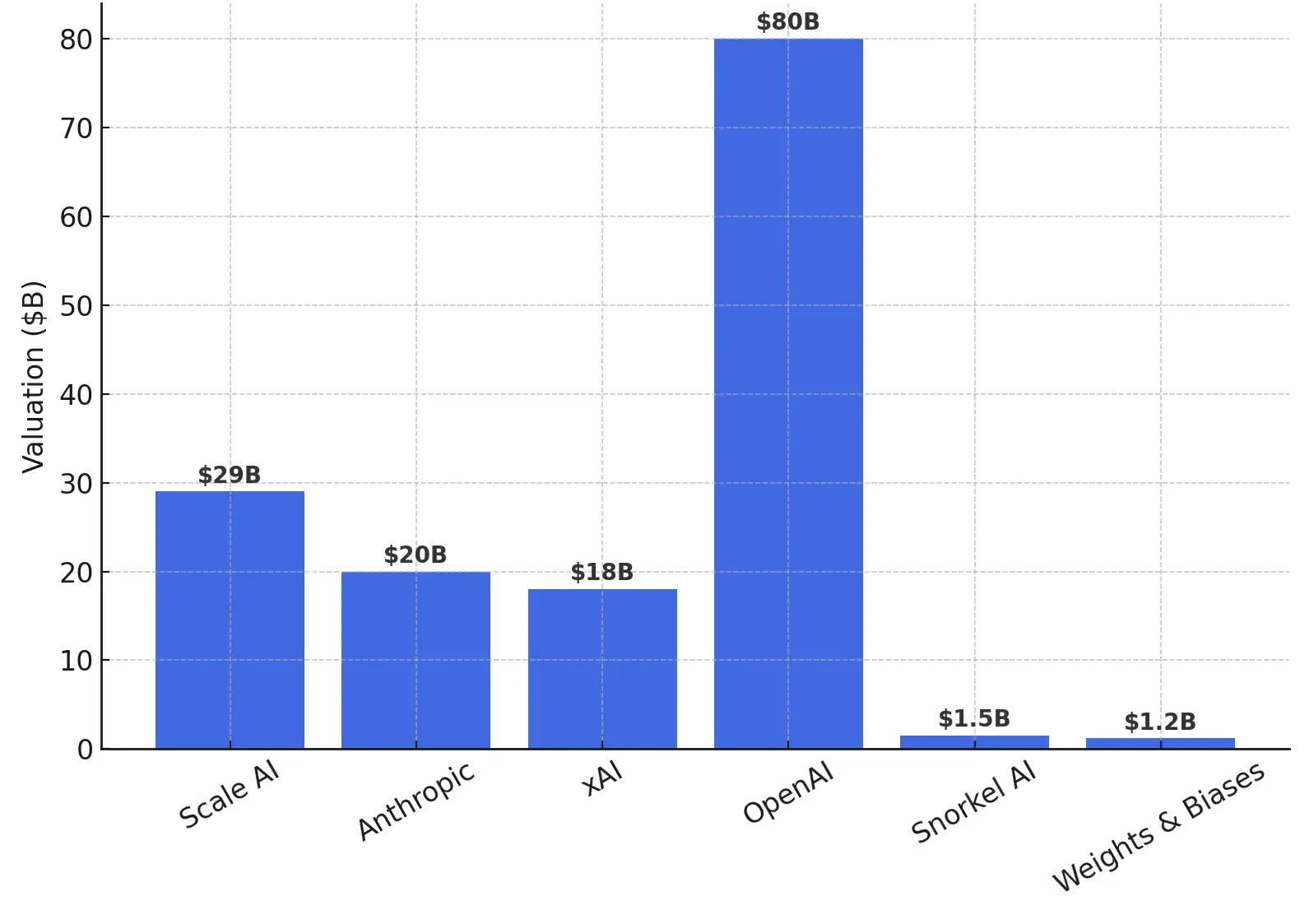
The Scale AI’s valuation, following the Meta deal, signals investor recognition that infrastructure plays a pivotal role in the AI value chain.
Conclusion
The Meta Scale AI deal is not just another investment in the crowded AI landscape. It represents a decisive structural move that could define Meta’s position in the race toward artificial general intelligence. By acquiring a 49 percent stake in Scale AI and bringing its CEO Alexandr Wang into the heart of its AI leadership, Meta has secured critical capabilities that extend far beyond model development.
This partnership fills the missing link in Meta’s AI strategy: a unified data and evaluation infrastructure that enables aligned, scalable, and safe AI systems. With Scale AI in its stack, Meta now controls the entire lifecycle from raw data ingestion to public deployment, with built-in red-teaming, benchmarking, and real-time feedback loops. This level of integration strengthens Meta’s competitiveness against OpenAI, Google DeepMind, and Anthropic, while positioning it as a long-term contender in AGI development.
Beyond Meta, the deal has created ripple effects across the ecosystem. It has elevated the value of infrastructure-layer companies, introduced new regulatory scrutiny, and accelerated the industry’s shift toward vertically integrated AI stacks. For investors, the message is clear: the future of artificial intelligence will be shaped not only by who builds the best models, but by who owns the systems that define trust, safety, and performance.
As AI transitions from experimentation to mass deployment, deals like this one are no longer optional. They are strategic imperatives. The Meta Scale AI deal may be remembered as one of the most pivotal inflection points in AI infrastructure history and a case study in how to win the next frontier of intelligent systems.
📚 References
- Bloomberg (2025), Meta Invests $14.3 Billion in Scale AI, Taking 49% Stake, Bloomberg News, June 10, 2025.
- Scale AI (2025), Our Technology: http://Scale AI (2025), Our Technology: Accelerating the Development of Aligned AI, Scale AI Inc. https://scale.com/technologyAccelerating the Development of Aligned AI, Scale AI Inc.
- CB Insights (2024), AI Infrastructure Market Map: Companies Powering the Next Wave of Intelligence, CB Insights Research.
- Stanford HAI (2024), AI Index Report 2024 – Chapter: Alignment and Evaluation, Stanford Human-Centered Artificial Intelligence Institute.
🔑Keywords:
Meta, Scale AI, Meta Scale AI deal, AGI leadership, artificial general intelligence, AI infrastructure, Meta AI strategy, Alexandr Wang, Scale AI valuation, AI startup investment, model alignment, red teaming, data labeling, LLaMA models, OpenAI competitor, AI evaluation tools, frontier AI, AI policy, AI investment 2025, AI industry news
